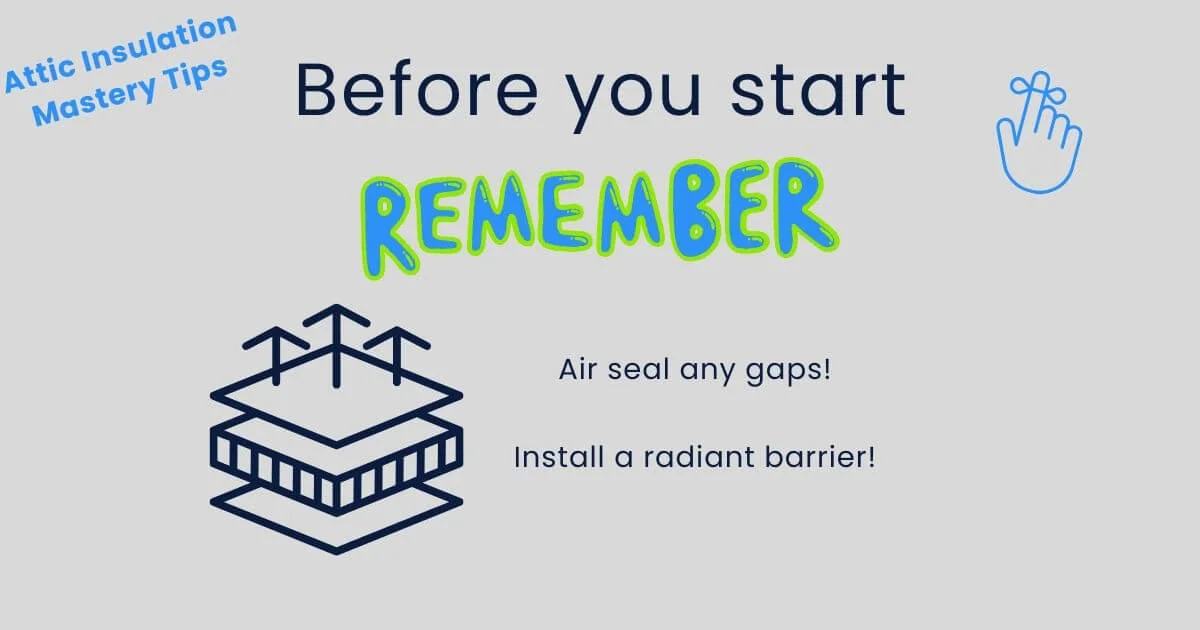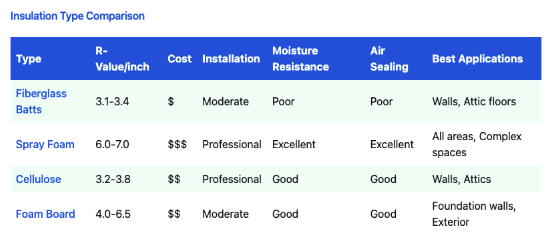Home Insulation Zones Guide: Maximize Your Home's Efficiency
Think of your home as a musical ensemble - every section needs to perform its part perfectly for the whole symphony to sound right. Just like how a single out-of-tune violin can affect the entire orchestra, one poorly insulated area can impact your home's overall comfort and energy efficiency. Each zone in your house plays its own unique role in maintaining temperature, from your attic floor down to your foundation walls.
Why Every Zone in Your Home Needs Different Insulation Strategies
Adding insulation isn't a one-size-fits-all solution. Your walls have different needs than your attic floor, and your basement walls face different challenges than your cathedral ceilings. Let's break down each zone and discover why they matter for your energy bill.
Starting at the Top: Attic Insulation Mastery
Your attic is like your home's hat – and just like how we lose body heat through our heads, homes lose a ton of heat through poorly insulated attics. The key to proper attic insulation starts with the attic floor. Install insulation between and over floor joists to create a strong thermal barrier between your living spaces and unconditioned attic space.
When adding insulation to your attic, pay special attention to knee walls and attic rafters - these areas often get overlooked but are major sources of heat loss. For those tricky corners and tight spaces, loose fill insulation provides excellent coverage without much disturbance to your existing setup.
Before you start any attic insulation project, remember these two game-changers:
Focus on proper air sealing to prevent energy loss through gaps and cracks
Consider installing a radiant barrier to reduce summer heat gain and keep your cooling costs down
The Core of Your Home: Wall Cavities and Living Spaces
Think of your exterior walls as your home's winter coat. The effectiveness of your wall insulation depends heavily on what's happening inside those wall cavities. First, you'll want to check existing insulation levels - many older homes have inadequate or settled insulation that's not doing its job anymore.
For homes with existing walls, the dense pack technique works wonders for filling wall cavities completely without removing exterior siding. This method helps resist heat traveling through your walls while creating an effective air barrier.
When planning your wall insulation strategy, consider these key factors:
Proper installation in both vertical walls and cathedral ceilings requires different approaches
Exterior siding condition can impact your insulation choices and installation methods
Don't overlook plumbing penetrations - they're sneaky sources of air leakage that can undermine even the best insulation
Below Ground Level: Basement Walls and Foundation
Your basement isn't just for storage – it's a key player in your home's thermal envelope. Let's start with foundation walls, which need special attention to prevent water intrusion while maintaining proper insulation levels. When you're insulating basement walls, you're actually creating a conditioned space that impacts your entire home's comfort and energy efficiency.
The approach to basement insulation varies depending on whether you're dealing with interior walls or exterior walls. For finished basements, you'll want to focus on creating a comfortable living space while meeting building codes for insulation. Even unfinished basements benefit from proper insulation - it helps control moisture and keeps your main living areas more comfortable.
Some advanced considerations for basement insulation include:
Choosing between interior insulation and exterior insulation based on your basement's conditions
Installing a proper vapor barrier to control moisture
Understanding how your basement walls interact with your home's overall insulation system
The Often-Forgotten Zones: Floors and Crawl Spaces
Just like wearing warm socks in winter, insulating floors keeps your whole house cozy. One often-overlooked area is the space above unheated garages - this is where floor insulation becomes absolutely vital for your comfort. Without proper insulation underneath, you might feel cold air seeping up through your floors, especially during those chilly winter mornings.
Vented crawl spaces present their own unique challenges. These spaces need special attention to prevent cold air from affecting your living spaces above. The key is creating an effective air barrier that works alongside your insulation. When installing insulation underneath your subfloor, pay careful attention to the floor joists - they can create thermal bridges if not properly addressed.
For maximum effectiveness when insulating floors:
Choose between foam board and fiberglass batting based on your specific situation
Ensure complete coverage around all floor joists
Address any air leakage before adding new insulation
Consider upgrading insulation levels if you notice temperature variations
Special Considerations for Building Components
When it comes to building components, every piece plays a unique role in your home's insulation system. For new construction projects, structural insulated panels offer excellent insulation value while simplifying the building process. These innovative materials are transforming how we think about building envelope efficiency.
Older homes often present challenges around ceiling joists and attic decking. The space between ceiling joists is prime real estate for insulation, but proper installation is crucial for effectiveness. When dealing with floor insulation above an unconditioned garage, you'll need to pay special attention to how different building components interact.
Here's what makes the biggest difference in component insulation:
Proper sealing around all building components to prevent air leaks
Strategic placement of insulation to maximize R value without compromising structural integrity
Careful attention to areas where different building materials meet
The Secret to Even Temperature Distribution
Creating even temperature distribution throughout your home is like conducting an orchestra - every section needs to play its part perfectly. The secret lies in balancing insulation levels across different areas of your home. When one zone is under-insulated, it affects how heat moves between living spaces, just like one out-of-tune instrument can throw off an entire symphony.
Understanding how heat travels through your home is crucial. Proper insulation helps resist heat traveling where you don't want it to go. In winter, this means preventing cold air from infiltrating your cozy spaces. During summer, it's all about managing cooled air distribution efficiently to maintain comfort without overworking your AC system.
For optimal temperature control:
Ensure consistent R value across connected zones
Address any gaps in your insulation system
Monitor how different areas of your home interact thermally
Pay attention to transition zones between conditioned and unconditioned spaces
Choosing the Right Insulation
Understanding how different insulation types resist heat traveling through your home's building components is key to making the right choice. Proper air sealing and maintaining recommended insulation levels in your wall cavities, cathedral ceilings, and vented crawl spaces directly impacts your energy bill.
Spray foam insulation creates an effective air barrier, making it ideal for sealing plumbing penetrations and preventing cold air infiltration. Loose fill insulation works exceptionally well for the attic floor and between floor joists. Using the dense pack technique, it can be added to existing wall cavities without disturbing exterior siding.
For foundation walls and basement walls, foam board delivers high insulation value in conditioned spaces. This makes it particularly valuable for finished basements where you need strong R value performance. When considering insulation underneath floors or above unheated garages, proper installation ensures you maintain even temperature distribution throughout your living spaces.
Strategic combinations of materials often work best:
Interior walls benefit from sound-dampening options
Exterior walls need proper air sealing
Attic insulation requires adequate ventilation
Ceiling joists need careful coverage
Now, let's explore professional installation approaches.
Professional Installation Tips for Different Zones
While you might be tempted to tackle insulation as a DIY project, certain areas demand professional expertise. Basement walls, for instance, require careful assessment to prevent moisture issues while maximizing insulation effectiveness. Cathedral ceilings present unique challenges that often need specialized installation techniques to maintain proper ventilation while achieving desired R value levels.
For existing homes, the dense pack technique can transform your wall cavities into highly efficient insulation zones. This method is particularly cost effective because it can be done without creating much disturbance to your daily life. However, it requires specialized equipment and expertise to execute properly.
Professional installers know how to:
Evaluate the best approach for your specific home configuration
Identify potential problem areas before they become issues
Install insulation to meet or exceed building codes
Ensure proper coverage in hard-to-reach areas
Balance ventilation needs with insulation requirements
R Value Requirements by Zone
Different areas of your home need different R values. Here's a quick guide:
Attic insulation: R-30 to R-60
Exterior walls: R-13 to R-21
Floor insulation: R-19 to R-30
Basement walls: R-10 to R-19
Cathedral ceilings: R-30 to R-49
Remember: these values might vary based on your climate zone and local building codes!
Common Mistakes to Avoid in Each Zone
Let's take a moment to learn from others' experiences with insulation projects. One of the most common issues we see involves attic ventilation. Homeowners sometimes get so excited about adding insulation that they accidentally block their attic's ventilation system, which can lead to moisture problems and reduced insulation effectiveness.
Basement walls present another tricky area. Many people focus on the insulation itself but forget about the vapor barrier. Without proper moisture control, your insulation can become compromised, leading to reduced R value and potential mold issues. Similarly, skipping proper air sealing before adding insulation is like trying to fill a bucket with holes - you're losing efficiency before you even start.
Watch out for these other common pitfalls:
Missing crucial spots in wall cavities during installation
Improper installation around ceiling joists that creates thermal bridges
Forgetting to account for proper ventilation in cathedral ceilings
Neglecting to seal around plumbing penetrations before insulating
Pro tip: Before starting any insulation project, take time to identify and address air leaks. Remember, even the highest R value insulation won't perform at its best if air can freely move around it.
Looking to the Future: Smart Insulation Choices
The world of home insulation keeps evolving, and staying informed about new technologies can help you make smarter choices for your home. Recent advances in insulation materials are revolutionizing how we think about temperature distribution in living spaces. These innovations help resist heat traveling through building components more effectively than ever before.
For existing home retrofits, new installation techniques are making it possible to add insulation with minimal disturbance to your daily life. Advanced air sealing methods are also improving how we approach energy efficiency in both new construction and older homes. These developments are especially exciting for homeowners looking to improve their insulation levels without major renovations.
Looking ahead, we're seeing promising trends in:
Smart materials that adjust their insulating properties based on temperature
Improved techniques for achieving higher R value in thinner spaces
Eco-friendly insulation options made from sustainable materials
Advanced methods for better conditioned space management
Innovative solutions for challenging areas like cathedral ceilings
Want to discover how these cutting-edge insulation solutions could benefit your home? Give us a call at Argyle Bros Insulation - we're always up to date on the latest techniques and technologies that can help make your home more comfortable and energy-efficient.
Ready to take the next step in optimizing your home's insulation? Contact us for a personalized assessment. We'll help you identify the most effective solutions for each zone in your home, ensuring you get the most value from your insulation investment. Remember, a well-insulated home is a comfortable home - and we're here to help you achieve that comfort while keeping your energy costs under control.






